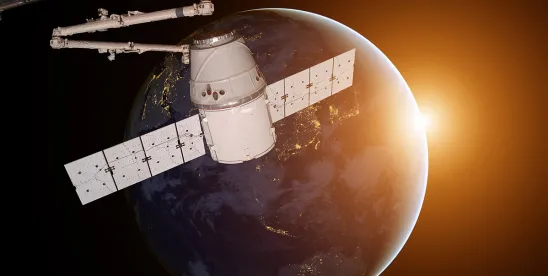On Sept. 6, the Federal Communications Commission adopted its schedule of regulatory fees for fiscal year 2024, enacting several significant changes for fee payors in the space station (e.g., satellite) and earth station categories.
Each year, the Commission must recoup annual appropriations by assessing fees on certain regulated entities. The FCC calculates the exact amount to be recouped from each fee payor category primarily by examining the “FTE burden,” or the full-time equivalent number of employees supporting the category. This is the first year the fees reflect the creation of the Space Bureau, a new Bureau established in April 2023 to better support the Commission’s space competencies. With this new support – and new FTEs – comes increased costs for the space industry.
The FY 2024 order makes the following changes to the Commission’s space and earth station fee categories:
- Codifies the Commission’s earlier decision to fee space stations performing rendezvous and proximity operations (RPO), on-orbit servicing (OOS), and orbital transfer vehicles (OTV) on an interim basis in the non-geostationary (NGSO) (Small Satellites) category, regardless of orbit. Relatedly, the Commission declined to revisit its interim conclusion that RPO and OOS space stations joined to geostationary orbit (GSO) space stations during operations should not be assessed separate regulatory fees.
- Adopts a proposal to update the allocation of total space station regulatory fees between GSO and NGSO licensees to 60/40, effective for FY 2024. Previously, the FCC assessed the fees on an 80/20 split between GSOs and NGSOs.
- Apportions regulatory fees between earth station and space station payors based on the percentage of FTEs involved in licensing and regulating each category. Whereas earth station FY 2023 fees were approximately 7.69% of the fees assessed for all earth station and space station fee payors, the FY 2024 fees are approximately 18.37%.
Between the reallocation of fees between certain categories of fee payors, and overall increased appropriations to be collected from space station and earth station payors, the FY 2024 fees may generate some sticker shock. Moreover, the Commission expressly declined to cap or phase-in space station and earth station regulatory fees for FY 2024, as some commenters had requested.
The final tallies? The table below lists the FY 2024 fees, as given by the order, and compares them to the FY 2023 fees to demonstrate the increased financial cost to the commercial space industry.
| Fee Payor Category | FY 2023 Amount | FY 2024 Amount |
| GSO (per satellite) |
$ 117,580 | $ 144,155 |
| NGSO (Other) (per operational system) |
$ 347,755 | $ 964,200 |
| NGSO (Less Complex) (per operational system) |
$ 130,405 | $ 441,925 |
| NGSO (Small Satellite) (per license) |
$ 12,215 | $ 12,215 |
| Earth Stations |
$ 575 | $ 2,610 |
For space companies with FCC authorizations, including foreign entities, the uptick in FY 2024 fees may generate friction against already-set company budgets.
Looking ahead, companies with existing or planned satellite operations may want to consider engaging with the FCC’s fees rulemaking process, as well as adding margin to regulatory budgets for FY 2025 and beyond. While the FCC deferred some substantial space station proposals for FY 2024, including assessing fees on authorized but not-yet-operational stations and assessing fees using an alternative methodology, the FY 2024 order signals the Commission’s intent to act on these issues in time for FY 2025. Inputs to the Commission in the coming months will be critical to cementing – or reshaping – the ultimate space station fee structure.


 />i
/>i

